TL;DR
Short answer: fix your lighting first, then layer color and texture in three to five repeated accents. To make a monochrome bedroom feel cozy without painting, switch every bulb to 2700K warm white, add two to three lamps at different heights, repeat one accent color (rust, sage, or teal) in at least three places, and upsize a few elements for proper scale.
When a finished room still feels unfinished

Warm lighting and subtle color accents quickly transform a neutral bedroom’s mood from cold to cozy.
A neutral bedroom can be calm, but it can also drift into “rental white with overheads” if the finishing layer is missing. The quickest way to make a monochrome bedroom feel cozy is to combine warm lighting, a clear color story, and better scale. Designers often advise tackling order of operations: lighting, then color and texture, then furniture placement. That sequence solves 80 percent of “something’s off” moments. If you can’t paint or wallpaper, don’t worry — you can still transform the mood with warm light, art, textiles, and smarter styling.
The fast fix: bedroom lighting that actually flatters (2700K, layered, consistent)
The simplest, highest‑impact upgrade in a bedroom is switching to 2700K bulbs and keeping color temperature consistent across the room. Warm white (around 2700 kelvin) makes skin tones look better and turns stark whites into creamy neutrals. • Use three points of light: one ambient (dimmed overhead or glow strip), one task (bedside lamps), and one accent (floor lamp or picture light). • Match every bulb to the same 2700K color temperature; mixing 4000K “daylight” with warm bulbs creates that odd, clinical split. • Put light where eyes are: the bottom of a bedside shade should sit near eye level when seated; most bedside lamps land 24–27 inches tall. • Add a dimmer. Experts recommend bedrooms dim to 10–30 percent at night. Smart bulbs make it easy to shift from energizing morning light to evening amber. One reader insight designers echo: the single change of swapping to 2700K and adding a second lamp made a “hotel‑clean but cold” room instantly inviting.
Anecdote
• A renter swapped every bulb to 2700K, added a rust throw and two pillows to match, and said the room “finally looked finished” — without touching paint. • A college grad lowered two floating shelves to relate to the headboard and edited them to five pieces total; the wall stopped feeling skimpy and started feeling styled. • One small-space couple slid a 52-inch storage bench to the foot of their bed, tucked luggage inside, and topped it with a textured throw; the room gained function and a focal line. • A self-described plant killer added a snake plant and a ZZ in matte pots; they thrive in low light and add that hit of living green most neutral rooms crave.
Color, contrast, and texture: repeat an accent 3 times
The quickest way to add warmth without painting is to repeat one accent color three to five times in different materials. Repeating color builds cohesion and looks intentional. • Pick a palette: rust and terracotta bring heat; sage or olive adds organic calm; teal or indigo creates crisp contrast with black and white. • Repeat your color in at least three places: a throw at the foot of the bed, two pillows, and art or a ceramic vase. The “rule of three” helps the eye connect the dots. • Layer texture for depth: linen bedding, a chunky knit throw, velvet cushions, woven baskets, a wood or rattan element, and a softer rug. • Ground the neutrals with a touch of black or dark wood. Designers often advise 10 percent dark accents to keep pale rooms from floating away. If rugs are in play, a warmer rug changes everything. For a queen bed, an 8×10 typically yields 24–30 inches of soft landing on both sides; for a full, a 6×9 often works.
Scale and placement: small decor in a big room reads unfinished
Right‑sized pieces make a room feel designed; underscaled items make it feel unfinished. A few well‑chosen upgrades can anchor the space. • Nightstands: the top should be within 2 inches of mattress height for comfort; add twin lamps for balance. • Bench at the bed: a 48–60 inch upholstered bench or storage ottoman adds function and presence. • Shelves: lower floating shelves so they visually relate to the bed; when styling, think odd numbers and negative space. • Art: aim to hang art so the center is about 57 inches from the floor, or build a gallery wall with 2–3 inches between frames. • Vanity wall: flank a mirror with artwork or sconces to add vertical rhythm and fill blank space. If you can only change one thing for scale, upsize the rug or the bedside lamps; those two elements carry surprising visual weight.
Quick wins for shelves, vanities, and that awkward space by the closet
Shelves, vanities, and closet corners finish a room when they’re styled with purpose and a little restraint. Edit first, then layer meaningfully. • Shelf styling: mix heights and textures, keep 20–30 percent empty, and repeat your accent color. Books, a trailing plant, one small framed print, and a tactile object is often enough. • Vanity zone: corral daily items on a tray, stash the rest in drawers, and add a small shaded lamp in warm tones. A 16–20 inch wide art piece to the left or right of the mirror fills that vertical void. • Closet corner: give the orphaned spot a job. Add a tall plant (ZZ or snake thrive in low light), a slim floor lamp, and a basket for throws. • Lighting detail: LED strip lights tucked into a ceiling recess or under floating shelves add ambient glow without glare. For the blank frame, use a personal moment: travel tickets, a printed phone photo, or a thrifted poster with your palette — the easiest way to inject personality fast.
Visualization Scenario
Picture nightfall: the overhead dimmed to 20 percent, two bedside lamps glowing at 2700K, a soft uplight brushing a tall plant by the closet. Rust linen pillows pick up the tone of a throw at the foot of the bed; a warm rug softens the tile underfoot. On the shelves, a small framed photo and a ceramic vase echo the palette. Everything feels softly lit, layered, and intentional.
FAQ
- How do I make a monochrome bedroom feel cozy without painting? Use 2700K warm lighting, repeat one accent color three to five times, and layer textures like linen, velvet, and woven baskets for depth.
- What’s the best lighting color temperature for bedrooms? Experts recommend 2700K for bedrooms and keeping every bulb the same temperature to avoid a harsh, clinical split.
- How should I style bedroom shelves above the bed? Keep 20–30 percent empty space, mix heights, repeat your accent color, and limit to 3–5 items per shelf to avoid visual clutter.
- What can I put next to my closet to fill the empty space? Add a tall low‑light plant, a slim floor lamp, and a lidded basket; this trio adds height, glow, and hidden storage.
- What size rug works under a queen bed? An 8×10 rug usually gives 24–30 inches of soft landing on both sides; center it so the nightstands sit fully on the rug or all off it.
Warm it, anchor it, repeat it
Most bedrooms that feel “almost there” are one lighting swap and three accents away from cozy. Warm every bulb to 2700K, anchor the bed with balanced nightstands and lamps, and repeat a single accent color across art, textiles, and a plant pot. Add texture you can feel — linen, velvet, rattan — and right‑size a few key pieces so the room looks deliberate. When light, color, and scale agree, neutral stops being cold and starts feeling like home.
.svg)

.svg)
.jpg)
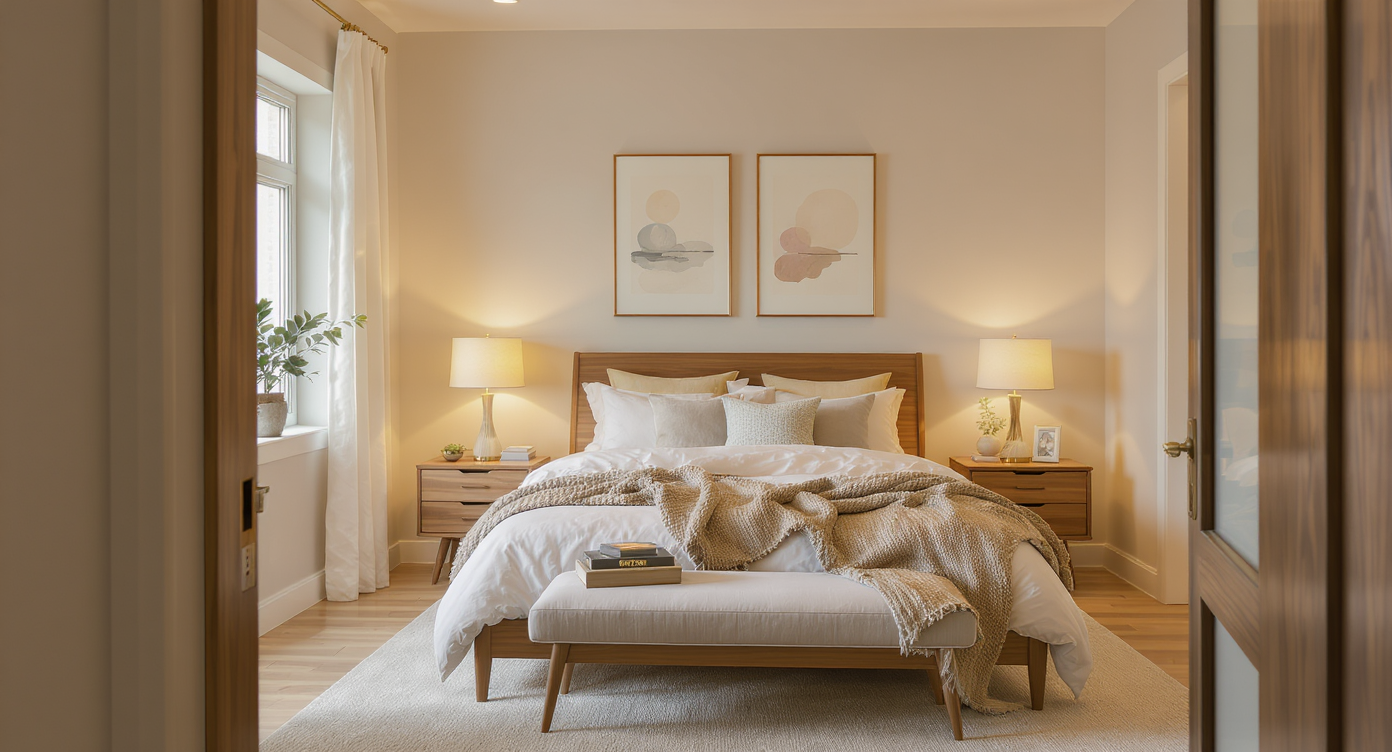
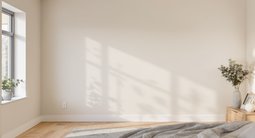
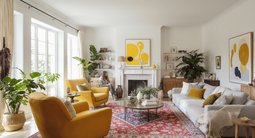




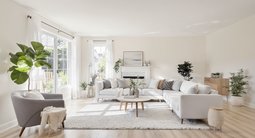

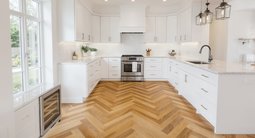



.png)